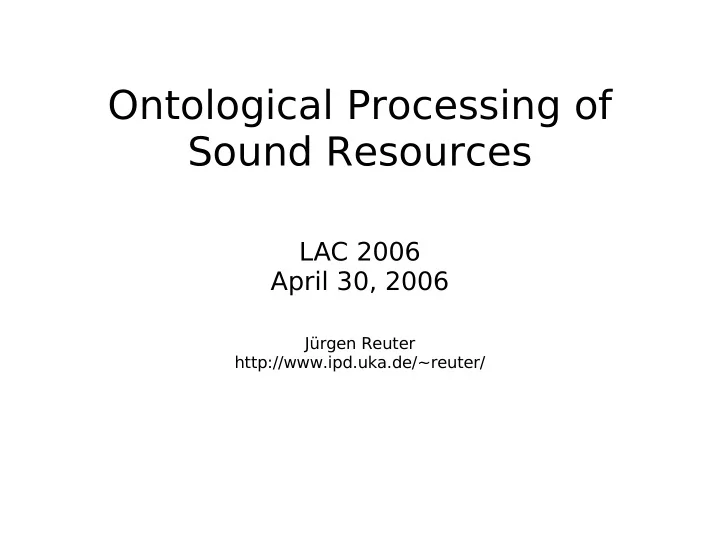

Ontological Processing of Sound Resources LAC 2006 April 30, 2006 Jürgen Reuter http://www.ipd.uka.de/~reuter/
Composers’ Real Hard Life ● “On which synth and in what sound bank was that cool trumpet sound?” ● “I somewhere saved that funny synth pad patch that I created for my last song, but where did I store it ?” ● “Give me a list of all the string synth sounds that are scattered across my synths and banks!” LAC 2006 — April 30, 2006 Ontolog. Proc. of Sound Resources 2
What’s the problem? ● Too many sounds in too many synths and synth banks ● Sounds mostly not at all sorted or ordered in a musical sense ● No standardized, uniform way of sound browsing or lookup across synths ● No central sound registry for a single lookup of sounds across all synths in a system LAC 2006 — April 30, 2006 Ontolog. Proc. of Sound Resources 3
How to Order Sounds? ● Instrument Taxonomies LAC 2006 — April 30, 2006 Ontolog. Proc. of Sound Resources 4
How to Order Sounds? (cont.) ● Acoustic Organ Registers – Classify by pitch ● 16’’, 8’’, 4’’, ... – Classify by construction principle of pipes ● labial / lingual pipes, open / closed pipes, ... – Classify by function of sound ● solo, principal, mixture, ... – Classify by similarity to prototype sounds ● flute, bassoon, trumpet, ... LAC 2006 — April 30, 2006 Ontolog. Proc. of Sound Resources 5
How to Order Sounds? (cont.) ● Grouping, banking – 128 GM Level 1 MIDI instruments, 16 groups – GM Level 2 banks LAC 2006 — April 30, 2006 Ontolog. Proc. of Sound Resources 6
How to Order Sounds? (cont.) ● Tagging – Generalizes grouping – Enables sound to be member of multiple groups – Serves for annotating qualities of a sound LAC 2006 — April 30, 2006 Ontolog. Proc. of Sound Resources 7
More on Tagging ● Find (at least) 4 types of tags – prototype-driven (similarity to known sound or group of sounds) ● string, violin, synth, percussive, bright, resonant, ... – function-driven (purpose of sound) ● effect, lead, melodic, drums, ... – construction-driven (way of creating) ● arpeggiator, decay, FM, vocoder, ... – user-defined ● favorites, ... LAC 2006 — April 30, 2006 Ontolog. Proc. of Sound Resources 8
More on Tagging (cont.) ● Tags are deductive – violin ⇒ string – drum ⇒ percussive – vocoder ⇒ synth – lead ⇒ melodic – ... ⇒ plain Relational Database Management System (RDBMS) not sufficiently expressive LAC 2006 — April 30, 2006 Ontolog. Proc. of Sound Resources 9
Ontology Management System (OMS) ● Builds upon description logics (aka concept languages) – represents decidable fragment of first-order logic – supports modeling in terms of classes, properties, and individuals ● Recently has become widely supported through OWL standard LAC 2006 — April 30, 2006 Ontolog. Proc. of Sound Resources 10
OMS vs. RDBMS ● Like a RDBMS, can serve as a central repository of information ● Unlike a RDBMS, also provides reasoning support for deducing knowledge LAC 2006 — April 30, 2006 Ontolog. Proc. of Sound Resources 11
Ontologies ● Classes – create classes for tags and groups of sounds LAC 2006 — April 30, 2006 Ontolog. Proc. of Sound Resources 12
Ontologies (cont.) ● Individuals – store actually available sound resources as class members LAC 2006 — April 30, 2006 Ontolog. Proc. of Sound Resources 13
Ontologies (cont.) ● Individuals – infer inherited class memberships LAC 2006 — April 30, 2006 Ontolog. Proc. of Sound Resources 14
Ontologies (cont.) ● Properties – associate each sound resource with related info (e.g. MIDI program number, ALSA port) LAC 2006 — April 30, 2006 Ontolog. Proc. of Sound Resources 15
Ontologies (cont.) ● Properties – associate each sound resource with related info (e.g. MIDI program number, ALSA port) LAC 2006 — April 30, 2006 Ontolog. Proc. of Sound Resources 16
Example: Protégé ● Ontology editor and knowledge-base framework – Developed at Stanford University – Open source (Mozilla Public License) – Supports ontology editing, browsing, consistency checking, reasoning, ... – Used here to demonstrate feasibility of ontological sound resource processing LAC 2006 — April 30, 2006 Ontolog. Proc. of Sound Resources 17
Example: Protégé (cont.) ● Query: Sound ∏ ∏ ∃ hasQuality.BassQuality ∏ ∃ hasQuality.SynthQuality ∃ livesOn.MU-50_1 LAC 2006 — April 30, 2006 Ontolog. Proc. of Sound Resources 18
Example: Protégé (cont.) ● Search yields 3 matches: LAC 2006 — April 30, 2006 Ontolog. Proc. of Sound Resources 19
Example: Protégé (cont.) ● Result details LAC 2006 — April 30, 2006 Ontolog. Proc. of Sound Resources 20
Example: Protégé (cont.) ● More on the “Lead” sound quality LAC 2006 — April 30, 2006 Ontolog. Proc. of Sound Resources 21
@ ALSA Developers ● Based on this presentation, – further elaborate a proper ontology – set up OMS that ● serves as central sound registry ● tracks available sound resources – design a registry management API ● Maybe promote ontological framework as cross-platform standard LAC 2006 — April 30, 2006 Ontolog. Proc. of Sound Resources 22
@ Synth Application Developers ● Announce sounds to central registry ● Annotate sounds with tags ● Announce tags to central registry ● Think about proper tags for standardization – Can lead to much cleaner synth design! ● Let synth GUI design be guided by ontology of tags LAC 2006 — April 30, 2006 Ontolog. Proc. of Sound Resources 23
Conclusion ● Management of sound resources is strongly desired. ● It is feasible based on an ontological framework. ● An OMS can serve as central registry. ● Applications should use query and update the OMS database. LAC 2006 — April 30, 2006 Ontolog. Proc. of Sound Resources 24
Questions? LAC 2006 — April 30, 2006 Ontolog. Proc. of Sound Resources 25
Recommend
More recommend